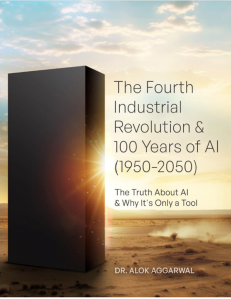
A summary of the second chapter of researcher and innovator Alok Aggarwal’s new book which explores Artificial Intelligence and how it will evolve in the future
— Alok Aggarwal
SAN JOSE, CALIFORNIA, USA, February 20, 2024 /EINPresswire.com/ — Alok Aggarwal’s recently published book “The Fourth Industrial Revolution & 100 Years of AI (1950-2050)” is currently topping charts in Amazon’s book categories like Cybernetics, Computer Engineering and Artificial Intelligence. As Dr. Aggarwal, the founder, CEO and Chief Data Scientist of Scry AI, aims to demystify the contemporary technological landscape regarding Artificial Intelligence (AI) and Data Science, we are publishing excerpts and press releases of each chapter to highlight what readers can expect.
Its second chapter titled, “Genesis of Artificial Intelligence and a Scientific Revolution: 1950-1979,” begins with a scene from Stanley Kubrick’s groundbreaking 1968 film, “2001: A Space Odyssey” and the unveiling of HAL 9000 series that sparked both excitement and skepticism in the world of AI. In this chapter, Aggarwal discusses the following:
1. Genesis of Artificial Intelligence: By asking whether a computer can fool a judge into believing that it is human, Turing’s Imitation Game in 1950 and the remarkable inventions during 1951-54 set the stage for the inception of AI. The term, “Artificial Intelligence” was formally coined by John McCarthy, a young professor who wrote a proposal in 1955 for organizing an AI conference in 1956.
2. A scientific revolution toppled the paradigm of traditional algorithms: Just like the paradigms related to Quanta and the Theories of Relativity toppled the Copernican paradigm and created a revolution in Physics, Machine Learning algorithms toppled the traditional algorithms’ paradigm, and created a scientific revolution related to Artificial Intelligence. After this paradigm shift, Computer Science became a separate discipline rather than being a part of Mathematics, Physics, or Electrical Engineering.
3. Euphoria soon led to many subfields of AI: This paradigm shift and the corresponding scientific revolution led to the evolution of statistical machine learning theory and the creation of various subfields of AI that constitute its backbone even today. These include Machine Learning, Expert Systems, Computer Vision, Natural Language Processing, Chatbots, Speech Recognition, and Speaker Recognition systems. Such systems also included building of non-Machine Learning systems that (a) can understand human languages, (b) are able to converse via written and oral formats, (c) have “vision” like humans, and (d) are able process information and answer questions posed to them.
4. Preliminary versions of Shallow and Deep Learning Networks were introduced: During the 1950s and 1960s, researchers provided theoretical underpinnings for Machine Learning networks that included single and multilayer Perceptrons, which essentially became known later as Shallow and Deep Learning Networks.
This chapter also delves into the audacious predictions made during this scientific revolution, fueling a hype cycle that led to remarkable progress, but resulting in the boom going bust. Indeed, such a bust occurred between 1973 and 1979, which was the first AI Winter. Such an inevitable collapse of the hype cycle, explored in this chapter, serves as a cautionary tale against overenthusiasm and overinvestment, and we seem to be going through a similar one today. Despite the boom and the bust during this era, this chapter concludes with a reflection on the profound impact of this scientific revolution and its enduring repercussions on the landscape of artificial intelligence.
As we revisit the past, this comprehensive retrospective serves as a guide for navigating the present and future of Artificial Intelligence, reminding us of the delicate balance between ambition and pragmatism. The lessons learned from the HAL 9000 era echo in the hallways of contemporary AI research, urging caution and resilience in the face of lofty expectations. The 9000 series may have been fictional, but its legacy lives on in the ongoing pursuit of AI excellence. This is particularly important today because various events in the AI field seem to be reminiscent of those that occurred between 1956 and 1979.
Overall, the book, “The Fourth Industrial Revolution & 100 Years of AI (1950-2050)” provides a concise yet comprehensive exploration of AI, covering its origins, evolutionary trajectory, and its potential ubiquity during the next 27 years. Beginning with an introduction to the fundamental concepts of AI, subsequent chapters delve into its transformative journey with an in-depth analysis of achievements of AI, with a special focus on the potential for job loss and gain. The latter portions of the book examine the limitations of AI, the pivotal role of data in enabling accurate AI systems, and the concept of “good” AI systems. It concludes by contemplating the future of AI, addressing the limitations of classical computing, and exploring alternative technologies (such as Quantum. Photonics, Graphene, and Neuromorphic computing) for ongoing advancements in the field. This book is now available in bookstores and online retailers in Kindle, paperback, and hardcover formats.
About Scry AI: Scry AI is a research and development company that uses AI and Data Science to help its clients in solving complex and extremely laborious problems. Founded in 2014 by Dr. Alok Aggarwal, Scry AI has developed more than 60 proprietary AI-based models and algorithms which constitute its CognitiveBricks platform of innovative business solutions. Scry AI’s family of enterprise solutions include: Collatio (for ingesting, extracting, and reconciling unstructured and structured data), Anomalia (for detecting anomalies and potential fraud), Concentio (for providing actionable insights using Internet of Things’ data), Vigilo (for predicting operational and marketing risks), and Data Flow Mapping (for extracting data lineage as data flows through disparate systems). Furthermore, these five product lines have 30 sub-products that achieve more than 90% accuracy and help Scry AI’s clients reduce their labor and costs by approximately 70%, which in turn, helps them to substantially improve the quality of their products and services. Scry AI was the recipient of the Best of San Jose Award in the Research category in both 2022 and 2023. It has offices in San Jose, California and both Gurgaon and Hyderabad, India. For more information, please visit: www.scryai.com
Alok Aggarwal
Scry AI, Inc.
+1 9149804717
email us here
Visit us on social media:
Facebook
Twitter
LinkedIn
Instagram
YouTube
![]()
Originally published at https://www.einpresswire.com/article/689763683/chapter-summary-genesis-of-artificial-intelligence-and-a-scientific-revolution-1950-1979



